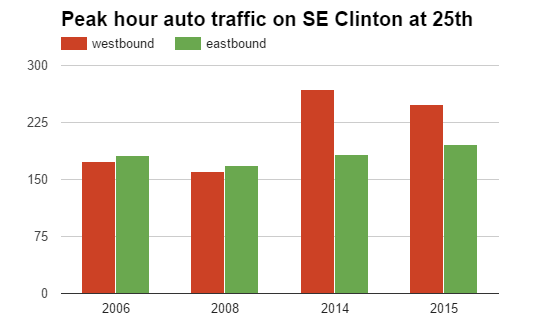
(Data: PBOT. Image: BikePortland)
For more than a year, as advocates and activists have worked to build public support for traffic diverters on Southeast Clinton Street, a question has hovered: are car volumes really worse than they used to be?
The freshly gathered data seems likely to bolster the case for diverters on Clinton Street that could reduce cut-through auto traffic on the important bikeway, especially once it becomes the main runway to the new Tilikum Crossing bridge in September.
In spring of 2014, the city measured 268 westbound cars during the morning rush hour on SE Clinton at 25th, a 66 percent increase over the 2008 level. But because that was in the middle of road work and construction on nearby Division Street, some said Clinton’s auto traffic might return to “normal” once Division’s new streetscape was finished.
According to traffic counts released by the city Tuesday morning, it hasn’t.
Westbound peak-hour auto traffic on Clinton near 25th remains 55 percent higher than it was in 2008. Eastbound traffic during the evening rush hour, by contrast, is up just 16 percent.
The new counts were conducted on Tuesday, June 9, a few days before the end of the Portland Public Schools trimester. The same data showed that traffic volumes on Clinton west of 30th Avenue are also among the highest in the neighborhood greenway system, carrying 129 westbound cars during the morning peak hour and 143 eastbound cars during the evening peak, for a total of 2,335 cars in both directions for the full day.
The national standard for neighborhood greenways — intended to be a citywide grid of low-stress, all-ages bikeways that build a long-term constituency for better biking — is to keep traffic volumes below 1,500 cars per day.
The freshly gathered data seems likely to bolster the case for diverters on Clinton Street that could reduce cut-through auto traffic on the important bikeway, especially once it becomes the main runway to the new Tilikum Crossing bridge in September.
But the data also raises new questions. What on earth is going on here? Why would more people be driving on Clinton in one direction but not in the other?
Advertisement
Fortunately, a team of volunteer biking advocates is already on the case. With support from Kari Schlosshauer and other members of the neighborhood group Safer Clinton, local transportation analyst Brian Davis (of Lancaster Engineering but working on his own time) led a squad of volunteers on June 2 to capture some of the richest data that’s ever been gathered about inner Southeast Clinton traffic patterns, including traffic volumes and turning movements from 7:35 to 8:35 a.m. and 4:40 to 5:40 p.m.
Based on their numbers, here’s a rough image that captures the phenomenon Davis thinks is happening:
“The problem gets worse heading west; Clinton seems to be ‘collecting’ the excess traffic from Division as you get closer to the central city,” Davis said in an email. “This is a phenomenon that doesn’t really have an evening equivalent, so we’re seeing lower volumes here. They’re still high, but not disproportionate to daily traffic.”
Davis (who readers may remember as, among other things, one of the creators of the “commercial greenway” concept for 28th Avenue and a post he titled “Requiem for a Greenway” about traffic changes on Clinton) used the turning movement data to come up with a concrete set of recommendations for Clinton.
Based on the counts and patterns Safer Clinton volunteers observed, Davis recommended three diverters:
– one NW-SE diverter at 28th Avenue
– a standard median diverter (a la 20th and Ankeny) at 17th
– a left-turn prohibition, excepting bikes and buses, northbound on 26th
That combination of diverters, Davis thinks, would reduce cut-through car traffic without interfering with local trips or the route of TriMet’s No. 10 bus.
Portland Bicycle Planning Coordinator Roger Geller, who coordinated the collection of fresh traffic data on Clinton, said the city is preparing to gather more information that will also be useful in understanding the area: the number of cars using Division Street each hour.
PBOT is currently analyzing Clinton and they are likely to install some mix of speed bumps, signage and diverters by the end of summer.


